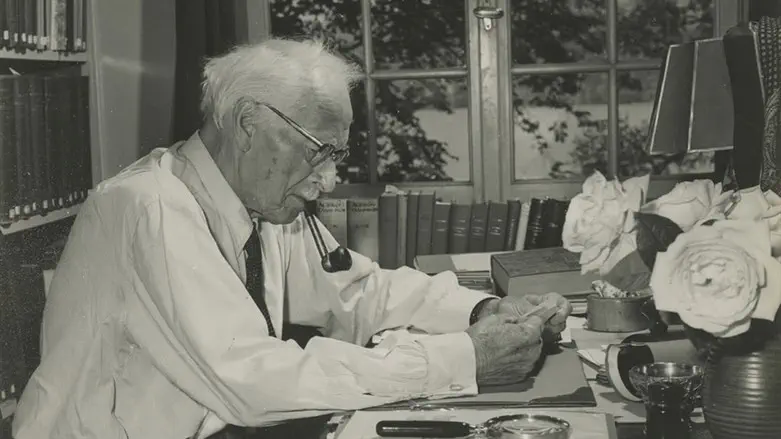
A unique collection of 62 handwritten and typewritten letters, signed by psychoanalyst Carl Gustav Jung, is up for auction at the Kedem Auction House in Jerusalem next week.
Some of the letters are addressed to the psychoanalyst Dr. Rivkah Schärf Kluger, and have never been printed or published. The large collection also contains photographs of Jung at his home in Küsnacht on the outskirts of Zurich.
Carl Gustav Jung was a Swiss physician and psychiatrist, one of the founding fathers of modern psychology, the father of analytical psychology, sometimes referred to as Jungian Psychology, and the theorist who gave rise to the concept of "collective unconscious." Jung was one of the most prominent of Sigmund Freud's students; Freud regarded him for a while as his natural successor, and even made certain he would be appointed President of his newly founded International Psychoanalytical Association.
Sixty-two letters bearing Carl Gustav Jung's signature (German) are in the collection. Most of sixty-two letters are handwritten on official stationery and bear Jung's signature. The letters were sent from 1940 to 1960 to Jung's student and close friend, the psychoanalyst Dr. Rivkah Schärf Kluger.
The letters deal with a wide range of personal and professional subjects and contain some intriguing references to Jung's theories. In his letters, Jung relates to various ideas and concepts connected to his own theories of analytical psychology; he consults with Dr. Schärf Kluger regarding the publication of his studies and works, provides her with guidance in editing and copy-editing her own research, tells her about the state of his own health, vacations, and plans, gives her all manner of advice, and more. In some of his letters, Jung psychoanalyzes Schärf Kluger's dreams – which she had told him about in her letters to him – by deciphering, interpreting, and clarifying them.
In some of the letters, Jung appears to be intrigued by the Hebrew language and Jewish texts. In one of them, dated May 24, 1944, he thanks Schärf Kluger for sending him a particular kabbalistic composition, and writes as follows: "This [the composition] strongly reinforces my own feelings and experiences. I was very impressed by it. In the darkest hours of my illness, every night I found myself in something of a ‘pomegranate orchard.'" [In all likelihood, the composition in question is the book by Rabbi Moses ben Jacob Cordovero titled ‘Pardes Rimonim' = ‘Pomegranate Orchard.'] In another letter, he thanks Schärf Kluger for providing him with an interpretation of the Hebrew word "rikmah" (= embroidery, tapestry, [biological] tissue).
In a letter dated April 3, 1946, Jung analyzes a particular dream Schärf Kluger had told him about, which appeared connected to the relationship between the two: "You stay too long – Hidden behind this is a desire to be part of my family. But I lead you out, – that is, out of the realm of ‘being a daughter' […] The card points to the pious Jew who has to teach you obedience. The apparatus that lengthens my nose is suggestive of the intention, that is, the distant goal one reaches when one pursues that nose. The small wriggling fish behind all this is the Christian symbol […] This is the part or the ‘self, ' the ‘atman' (from Old High German = breath, Holy Spirit) that a person internalizes, aspires to bring closer, that which enables one to breathe (‘Spiritus Vitae, ' [the ‘spirit of life']), in other words, that which enables life. Life is sacrifice, that is, any form of fulfillment is sacrifice, because completion is both a beginning and an ending… the ‘self' lives only insofar as we live our lives according to reality. Through illusions we distort reality and attempt to avoid it."
In another letter, dated November 11, 1944, Jung writes to Schärf Kluger as follows: "It seems to me every time something is constellated in your unconscious, threatening dreams are aroused, because you usually react to your unconscious as if it were something pathological. This is a form of overreaction, and is far too pronounced, and is apparently related to the fact that you dropped abruptly, shall we say, from the Middle Ages into the Modern Era – actually to the pinnacle of modernity." In yet another letter, dated August 30, 1943, Jung confides to her that, "It so happened that you once suddenly appeared in one of my dreams, but I can't remember the context."
Besides Jung's letters, the collection includes forty-one photographs, including photos of Carl Gustav Jung at home in Küsnacht, on the outskirts of Zurich. Some of the photos show him in his study room, or working in the yard outside his house, or with members of his family, colleagues, and acquaintances, and more. Two of the photographs (portrait photographs of Jung) were taken by Margarita Fellerer; one of them is signed by Jung.
"This unique collection sheds light on various aspects of Jung's life and philosophy," said Meron Eren, Kedem Auction House CEO and co-founder. "This is a true treasure to see such a large collection of unseen letters uncovered and published. A rare occasion for researchers, students, and all who study Jung’s heritage."

